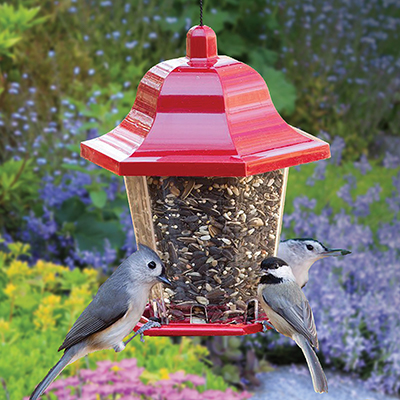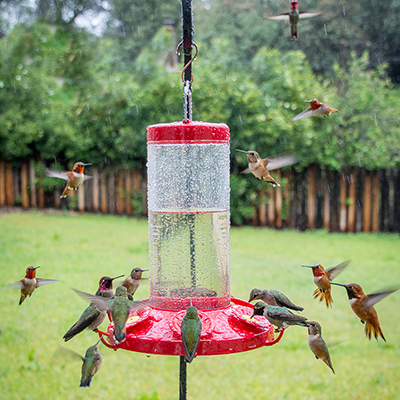How to Feed Birds
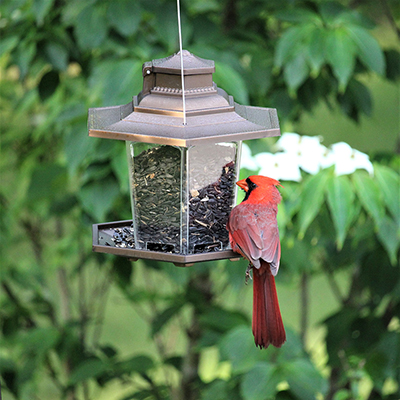
Last updated September 7, 2023
Picture this: you’re watching from your window when a cardinal stops to visit a feeder stocked with sunflower seeds. The next day, a woodpecker swoops in for a peanut. It’s fun and satisfying to feed wildlife.
Use this guide to learn how to feed birds and enjoy them in your yard.
Table of Contents
Platform Feeders
Hopper Feeders
Tube Feeders
Hummingbird Feeders
Suet Feeders
Fruit Feeders
Platform Feeders
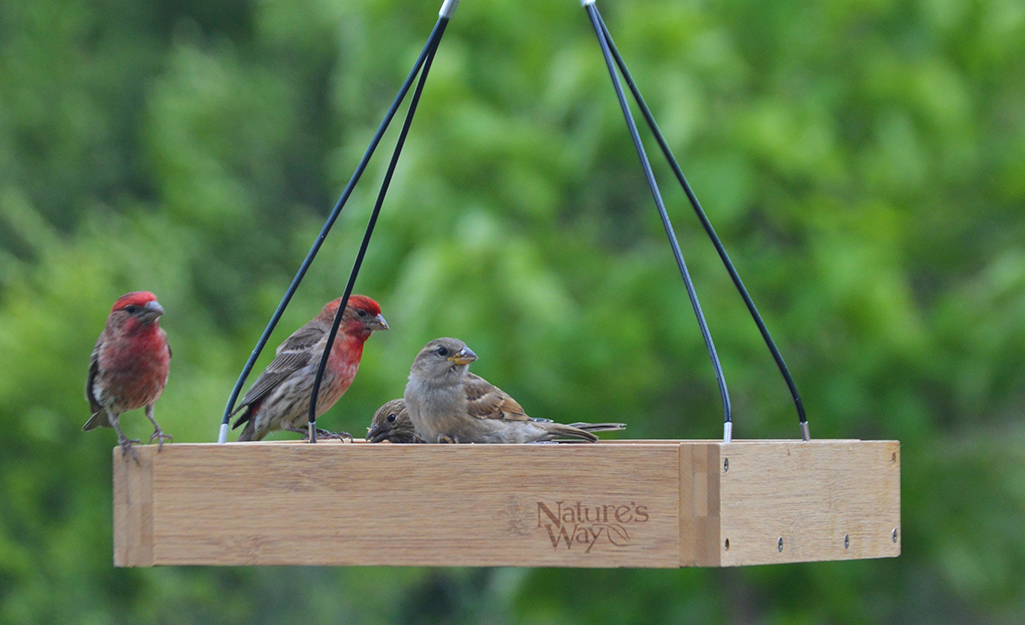
A platform feeder, sometimes called a tray feeder, invites birds to fly in and fill up. Also known as universal feeders, platform feeders let you offer the widest variety of feeds to your birds and wildlife. They're the most popular choice for photographers. The open design allows for optimum bird viewing. They also have ample space for large birds, such as jays and mourning doves.
Since tray feeders have an open design, they expose seed to the elements. Look for one with drainage holes or a fine mesh or wire screen at the bottom so rain can drain away. This will help keep the seeds fresh and prevent feeder rot. If your seeds do become wet and spoiled, dump them into the trash. Replace them with fresh ones, so birds won’t eat the spoiled seeds and become ill. Before refilling, scrub the feeder. Use a mild solution of unscented dish detergent and warm water. You can sanitize the feeder with a solution of nine parts water to one part bleach. Rinse the feeder thoroughly. Allow it to dry completely before you refill it.
For even more protection from rain, ice and snow, choose a platform feeder with a top or add an optional, see-through dome. A dome can also discourage squirrels from raiding your seeds. To further raid-proof your feeder, use a squirrel baffle. Hang the bird feeder away from trees, shrubs and other objects that squirrels can jump from.
Also, watch for cats that might climb or jump onto the feeder.
To attract jays, mourning doves, cardinals, chickadees, goldfinches, grosbeaks, juncos, nuthatches and titmice to platform feeders, offer black oil sunflower seeds, mixed seeds, nut, hulled sunflower seeds, striped sunflower seeds, safflower seeds and cracked corn.
Hopper Feeders
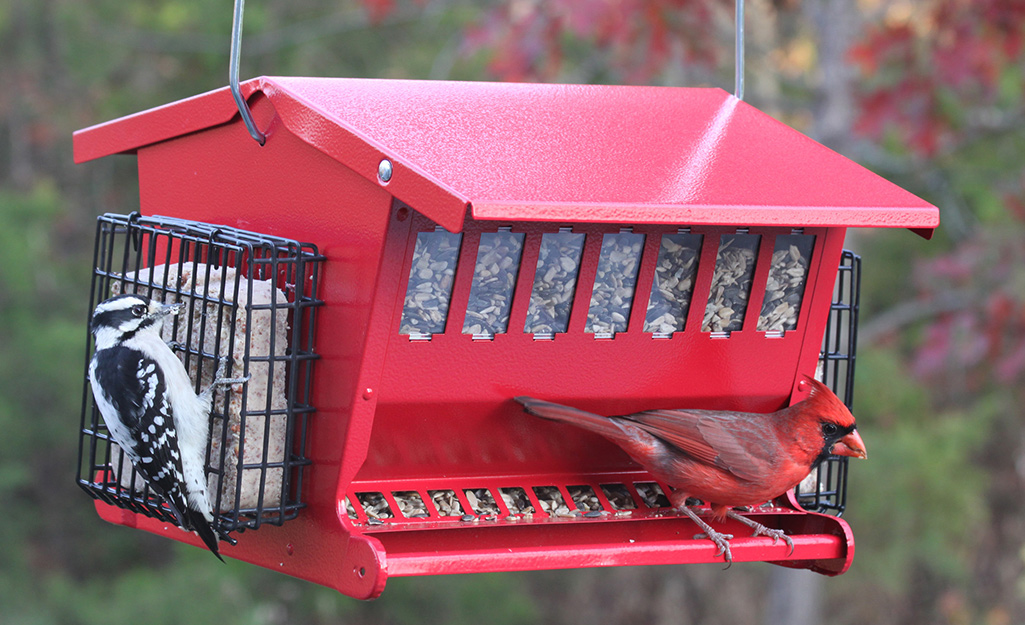
A hopper feeder has an enclosed seed chamber with a tray base. These covered feeders attract a wide variety of birds, while protecting feed from the elements. Still, it’s still important to look for a hopper feeder with adequate drainage. A mesh base lets air circulate so seed stays fresher longer. Hopper feeders come with or without suet cages at the ends. A hopper feeder with suet cages is like two feeders in one.
To attract jays, cardinals, chickadees, goldfinches, grosbeaks, juncos, nuthatches, titmice, hairy and downy woodpeckers and wrens to hopper feeders, offer black oil sunflower seeds, mixed seeds, striped sunflower seeds, cracked corn, hulled sunflower seeds, safflower seeds and suet cakes.
Tube Feeders
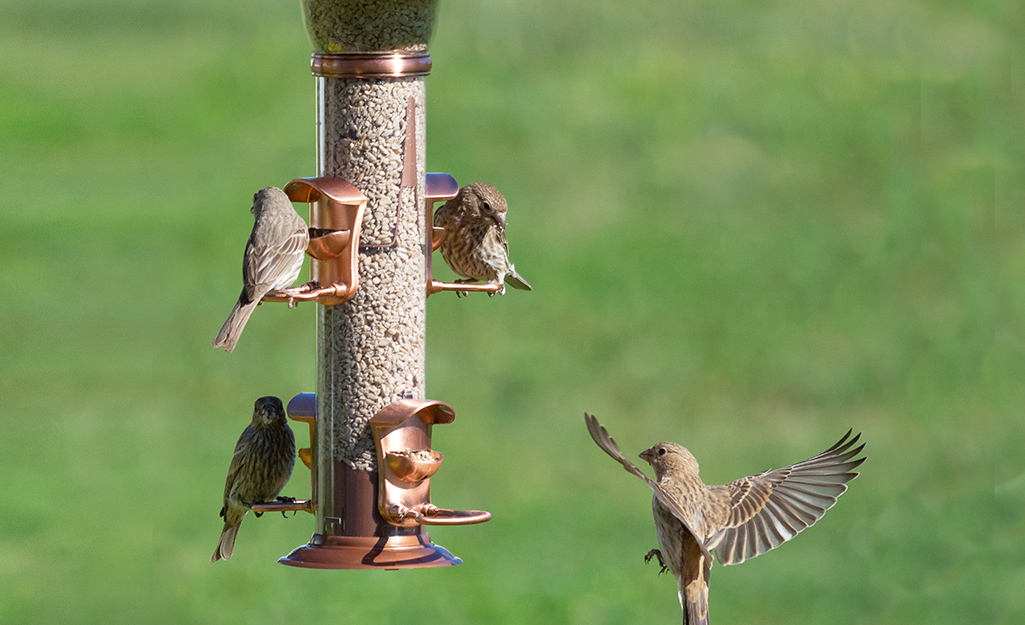
Tube feeders are popular for attracting smaller birds like pine siskins, goldfinches and titmice. They usually come with multiple perches, so several birds can dine at once. Some tube feeders have seed baffles inside. These baffles help hold seed at multiple levels within the tube, so seed stays available at all the feeding stations as the feeder empties.
The enclosed tube keeps seeds dry and fresh. Rain doesn’t usually get in through the small feed ports on the sides. A feeder with a removable base and ports allows for thorough cleaning. Keeping a feeder clean helps backyard birds stay healthy. Regular cleanings also prolong the life of your feeder.
Tube feeders with larger seed openings can be used for a variety of seeds such as sunflower seeds and mixed seed blends. Tube feeders with very small openings are specifically designed for thistle, also called Nyjer. Thistle isn’t commonly eaten by a wide variety of birds, but can be great for attracting gold finches, house finches and pine siskins. Some tube feeders have two-in-one seed ports. An insert or attachment can be used to convert the ports between large openings for sunflower seeds to small openings for thistle.
To attract cardinals, chickadees, goldfinches, grosbeaks, juncos, nuthatches and titmice to tube feeders, offer black oil sunflower seeds, striped sunflower seeds, hulled sunflower seeds, safflower seeds and thistle (Nyjer).
Hummingbird Feeders
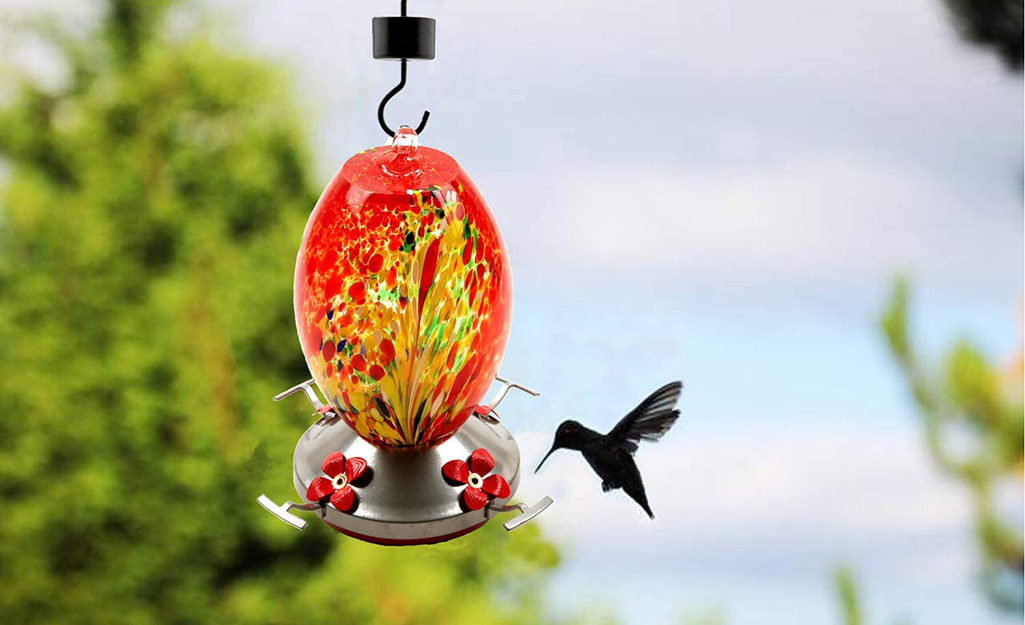
Hummingbirds appear in most parts of the country in early April. They love to zip in and visit hummingbird feeders filled with a mixture of one part sugar to four parts
water, the liquid nectar that they drink.
Boil the water if you make your own nectar, then stir in the sugar and be sure the mixture cools completely before filling your feeders. Do not add red food coloring.
Hummingbird feeders come in many shapes, sizes, styles and colors. Look for a few key features. A clear or transparent nectar reservoir lets you see when to change or refill the nectar. A feeder with built-in perches gives hummingbirds a place to rest while they drink. As they perch, you can get a better look at them.
Change the nectar frequently, or at least twice a week, depending on the temperature outside and where the feeder is hung. How often you change the nectar will also depend on the number of hummingbirds and how often they come to feed. The sugary nectar can mold and spoil if it is not changed often and can harm the tiny birds.
Choose a feeder that comes apart easily for thorough cleaning. Some hummingbird feeders are dishwasher safe, which makes sanitizing much easier.
If the birds don’t empty your feeder between cleanings, fill it with only the amount of nectar they will consume in a few days. Over time you’ll get a feel for how much to use. If the nectar turns milky, or white strings or black spots start to grow in it, change it more often.
Suet Feeders

Suet feeders are specially designed feeders that hold suet cakes. Suet is a mixture of rendered fat, nuts, berries and seeds. Because it's high in calories, suet is beneficial for birds in cold climates. It's also a great food source for birds just leaving the nest, as well as a wonderful source of energy for birds during migration. Woodpeckers, nuthatches, chickadees and titmice love suet. They often hang upside down to reach it.
Woodpeckers, are specially designed feeders that hold suet cakes. Suet is a mixture of rendered fat, nuts, berries and seeds. Because it's high in calories, suet is beneficial for birds in cold climates. It's also a great food source for birds just leaving the nest, as well as a wonderful source of energy for birds during migration.Woodpeckers, nuthatches, chickadees and titmice love suet. They often hang upside down to reach it.
If you have a lot of woodpeckers, consider a feeder with a “tail prop.” This small piece of wood extends underneath the feeder to help support birds with long tails. If you find that you’re attracting unwanted birds to your suet, an upside-down suet feeder design is a great natural deterrent. A majority of nuisance birds cannot feed comfortably hanging upside down.
Fruit Feeders

Fruit feeders are feeding stations that let you offer slices of oranges and apples, grapes, cherries, raisins, berries and plums. These fruits attract birds like Baltimore orioles, blue jays, robins and some chickadees and grosbeaks. If you’re not certain which birds eat fruits, think about the birds you’ve seen eating fruits that drop naturally from trees and bushes. Those same birds will enjoy dining on the fresh, ripe fruits you supply.
Tray feeders and certain suet cages can double as fruit feeders. You can also attract some fruit-loving birds with specially made nectar and jelly feeders. Grape jelly for birds is an easy-to-feed treat that is a favorite of orioles and even woodpeckers.
To attract Baltimore orioles, bluebirds and red-bellied woodpeckers, offer fruits and/or jelly for birds in fruit feeders.
Seeds and Nectar
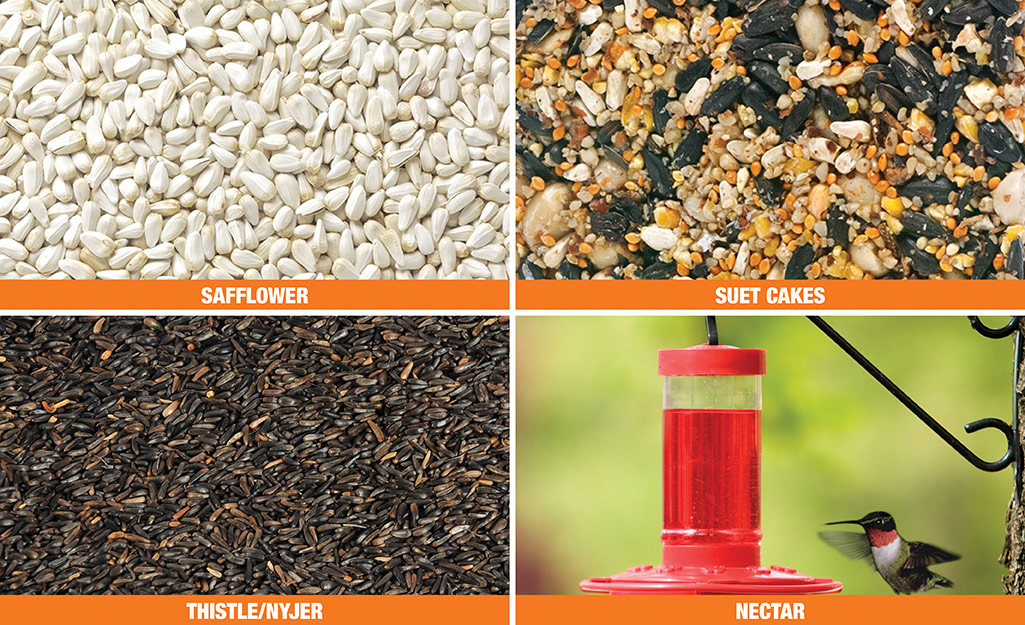
Feeders can hold many different kinds of seeds and/or suet cakes. Black oil sunflower seeds are a great choice for bird feeders. The shells are easy for most birds to crack. The kernel inside is high in fat and provides much-needed energy. Even birds that can’t open the seeds can feast on the pieces that fall to the ground. Black oil sunflower seeds attract a wide
diversity
of feathered friends.
Mixed seeds are a less costly choice. Mixes can include safflower seeds, flax, milo, millet, cracked corn and some kinds of sunflower seeds, among others. Not all birds will eat all the seeds in a mix. As you learn how to feed birds, experiment to see what the visitors to your yard prefer.
Ready-made nectar is available if you don't want to make your own.
Feeders should be hung or mounted
at
less
than
3
feet or
more
than 15 feet from a window to help prevent fatal window collisions. When possible, place your feeder roughly 10 feet from a natural shelter such as trees or shrubs.
This placement lets birds rest
between feedings and
find a
quick refuge from predators. Be careful not to put feeders much closer than 10 feet from trees or shrubs, as this can increase the likelihood
that squirrels will steal your seeds.
Figuring out how to feed birds can help you attract a variety of species to your yard. You may want to keep a birdwatching journal to make a note of all the birds you see.
Keep your feeders full, so birds will return to your yard often. Provide a clean, fresh supply of drinking water in a bird bath, too. Check the water often during the winter to make sure it doesn't freeze.
Want to buy bird feed, feeders and other supplies for your backyard birds? The Home Depot delivers online orders when and where you need them.






